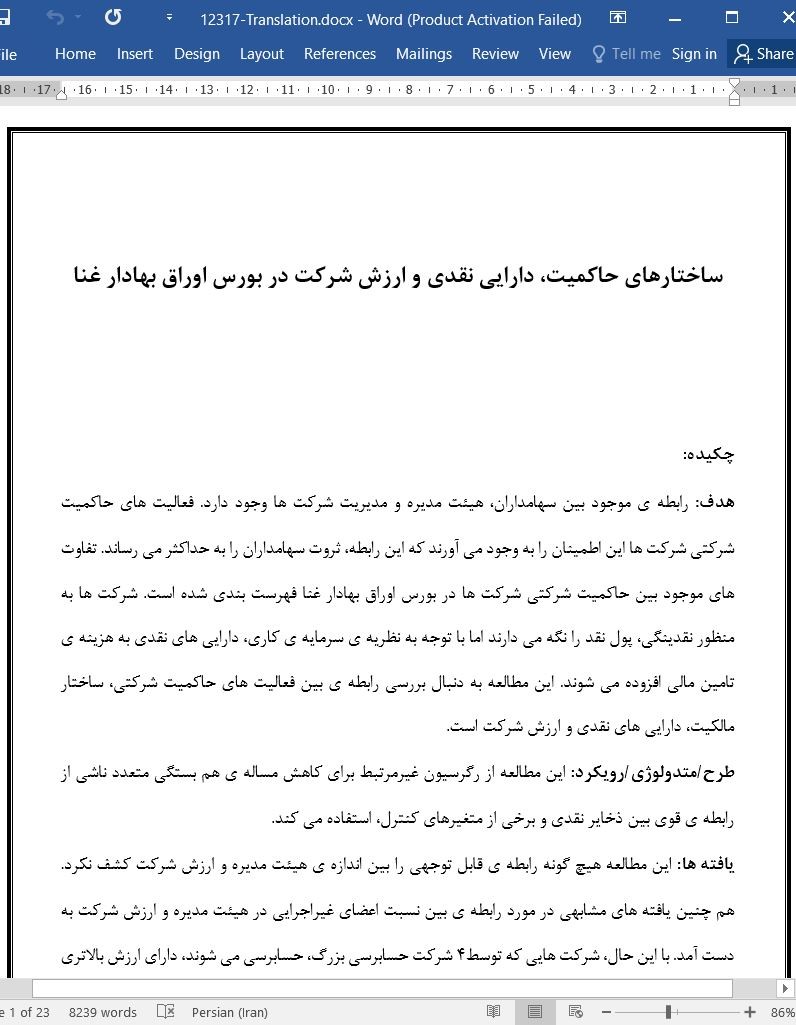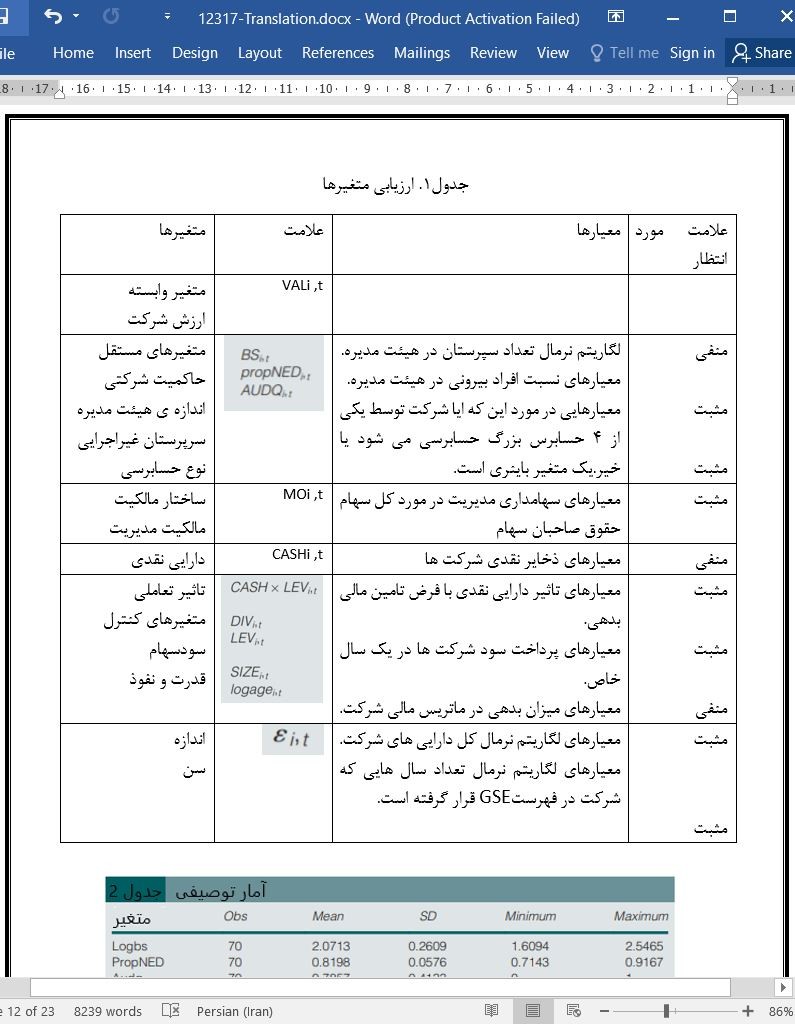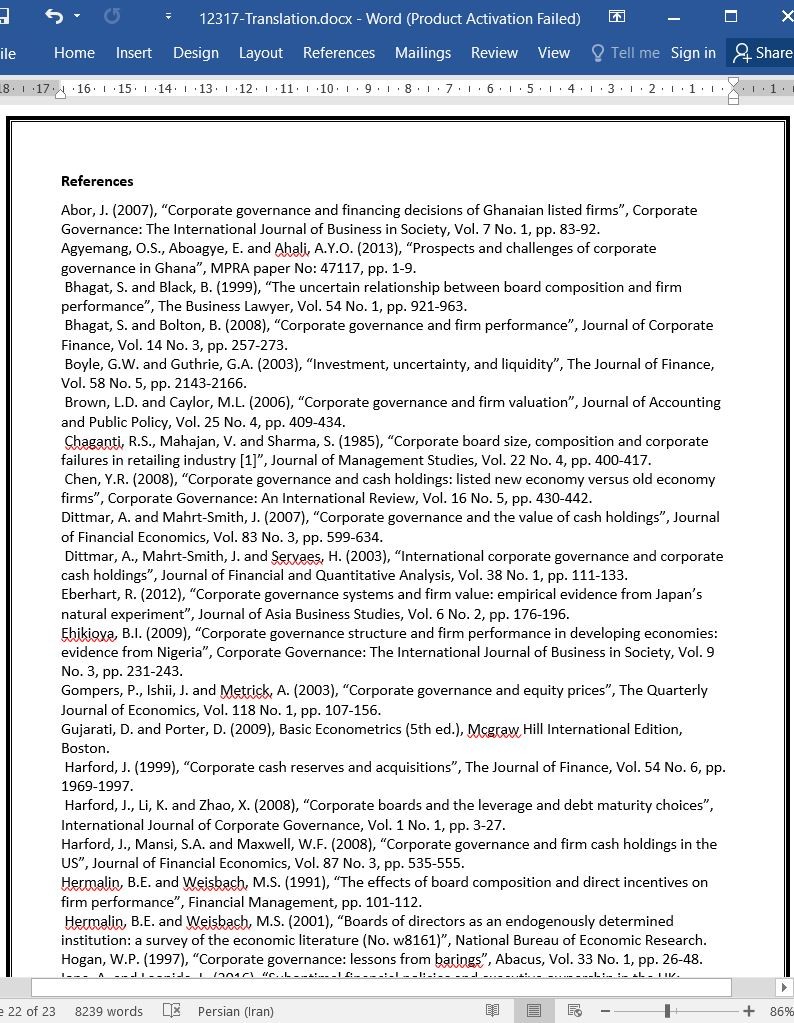
ساختارهای حاکمیت، دارایی نقدی و ارزش شرکت در بورس اوراق بهادار غنا
چکیده:
هدف: رابطه ی موجود بین سهامداران، هیئت مدیره و مدیریت شرکت ها وجود دارد. فعالیت های حاکمیت شرکتی شرکت ها این اطمینان را به وجود می آورند که این رابطه، ثروت سهامداران را به حداکثر می رساند. تفاوت های موجود بین حاکمیت شرکتی شرکت ها در بورس اوراق بهادار غنا فهرست بندی شده است. شرکت ها به منظور نقدینگی، پول نقد را نگه می دارند اما با توجه به نظریه ی سرمایه ی کاری، دارایی های نقدی به هزینه ی تامین مالی افزوده می شوند. این مطالعه به دنبال بررسی رابطه ی بین فعالیت های حاکمیت شرکتی، ساختار مالکیت، دارایی های نقدی و ارزش شرکت است.
طرح/متدولوژی/رویکرد: این مطالعه از رگرسیون غیرمرتبط برای کاهش مساله ی هم بستگی متعدد ناشی از رابطه ی قوی بین ذخایر نقدی و برخی از متغیرهای کنترل، استفاده می کند.
یافته ها: این مطالعه هیچ گونه رابطه ی قابل توجهی را بین اندازه ی هیئت مدیره و ارزش شرکت کشف نکرد. هم چنین یافته های مشابهی در مورد رابطه ی بین نسبت اعضای غیراجرایی در هیئت مدیره و ارزش شرکت به دست آمد. با این حال، شرکت هایی که توسط4 شرکت حسابرسی بزرگ، حسابرسی می شوند، دارای ارزش بالاتری در بازار سرمایه هستند. دارایی های نقدی شرکت ها به طور منفی بر عملکرد آنها تاثیر می گذارد، و این امر به لحاظ آماری بسیار قابل توجه است. در نتیجه ی تامین مالی بدهی، رابطه ی مثبتی بین دارایی های نقدی یک شرکت و ارزش آن به وجود می آید، اگر چه این رابطه چندان قابل توجه نیست.
منشا/ارزش: این مطالعه، اولین مطالعه ای است که از Tobin Q به عنوان ابزاری از ارزش شرکت برای انعکاس ارزش گذاری سرمایه گذاران شرکت ها در غنا استفاده می کند. هم چنین اولین مطالعه ای است که تاثیر تعاملی تامین مالی بدهی و دارایی های نقدی را بر ارزش شرکت در کشور غنا مورد آزمون قرار می دهد.
5.نتیجه گیری
مکانیزم حاکمیت شرکتی، ساختار مالکیت و دارایی های نقدی، عوامل مربوط به سازمان هستند که ریسک غیرسیستماتیکی را برای سهامداران یا شرکت کنندگان حقوق صاحبان سهام در بازار سرمایه ایجاد می کنند. بنابراین، این مطالعه با استفاده از نمونه ی شرکت های موجود در بورس اوراق بهادار کشور غنا در می یابد که آیا این متغیرها تاثیر قابل توجهی بر ارزش شرکت ها دارند یا خیر. این مطالعه از Tobin Q معیار نسبی برای ارزیابی ارزش شرکت استفاده کرده است. این مطالعه از SUR استفاده نموده و نتایج ترکیبی برای رابطه ی بین متغیرهای حاکمیت شرکتی و ارزش شرکت یافت. انداره ی هیئت مدیره ی شرکت ها و نسبت سرپرستان غیراجرایی در هیئت مدیره ی شرکت ها، رابطه ی قابل توجهی با ارزش شرکت ندارند. این نتایج با یافته های اسحاق و همکارانش در سال2009 مطابقت دارند. این مطالعه نشان می دهد که شرکت هایی که توسط 4حسابرس بزرگ حسابرسی می شوند، ارزش بالاتری را نسبت به شرکت هایی نشان می دهند که توسط سایر شرکت ها حسابرسی می شوند. نتایج نشان می دهند که مالکیت مدیریت دارای رابطه ی مثبت و قابل توجه با ارزش شرکت است. با این حال، دارایی های نقدی شرکت های موجود در بورس اوراق بهادار کشور غنا دارای رابطه ی منفی با ارزش شرکت هستند.
Abstract
Purpose There is an existing relationship among shareholders, boards of directors and management of companies. Corporate governance practices of companies are expected to ensure that this relationship maximises the wealth of shareholders. Differences exist among corporate governance of companies listed on the Ghana Stock Exchange. Companies, for purposes of liquidity, hold cash, but cash holdings also add to the cost of financing, according to working capital theories. The study, thus, sought to examine the relationship between corporate governance practices, ownership structure, cash holdings and firm value.
Design/methodology/approach The study deployed the seemingly unrelated regression to reduce the problem of multicollinearity resulting from the strong relationship between cash reserves and some control variables.
Findings The study found no significant relationship between board size and firm value. Similar findings were also made on the relationship between proportion of non-executive directors on the board and firm value. However, firms audited by the big four audit firms are valued higher by the capital market. Cash holdings of firms negatively affect performance, and this is statistically significant. A positive relationship arises between a firm’s cash holdings and its value as a result of debt financing, even though this is not significant.
Originality/value The study is the first of its kind that deploys Tobin’s Q as a measure of firms’ value to reflect investors’ valuation of firms in Ghana. The study is also the first of its kind to test the interactive effect of debt financing and cash holdings on firm value in Ghana.
5. Conclusion
Corporate governance mechanism, ownership structure and cash holdings are entityspecific factors that introduce unsystematic risk to shareholders or equity participants in the capital market. Hence, the study sought to find out whether these variables significantly influence value of firms, using a sample of companies listed on the GSE. The study used the Tobin’s Q, a relative measure to measure firm value. The study used the SUR and found mixed results for the relationship between corporate governance variables and firm value. Board size of firms and proportion of non-executive directors on firm’s boards has no significant relationship with firm value. These results agree with the findings of Isshaq et al. (2009). The study revealed that firms audited by the big four auditors show higher value than firms audited by the other firms. The results showed that management ownership has a positive and statistically significant relationship with firm value. However, cash holdings of firms listed on the GSE have an identified negative relationship with firm value.
چکیده
1.مقدمه
2.مروری بر ادبیات و توسعه فرضیات
2.1چارچوب نظری
2.1.1نظریه ی نمایندگی
2.1.2نظریه جریان نقد آزاد
2.2ادبیات تجربی
2.2.1حاکمیت شرکتی و ارزش شرکت
2.2.2ساختار مالکیت و ارزش شرکت
2.2.3دارایی نقدی و ارزش شرکت
2.2.4چارچوب مفهومی
3.داده ها و متدولوژی
3.1منابع داده ها
3.2مدل اقتصادسنجی
4.نتایج تجربی
4.1بررسی استحکام و قابلیت اطمینان
4.2 بحث یافته ها
5.نتیجه گیری
5.1توصیه ها و پیشنهادها
5.2توصیه هایی برای پژوهش آینده
منابع
Abstract
1. Introduction
2. Literature review and hypothesis development
2.1 Theoretical framework
2.1.1 Agency theory
2.1.2 Free cash flow theory
2.2 Empirical literature
2.2.1 Corporate governance and firm value
2.2.2 Ownership structure and firm value
2.2.3 Cash holdings and firm value
2.2.4 The conceptual framework
3. Data and methodology
3.1 Sources of data
3.2 Econometric model
4. Empirical results
4.1 Robustness checks
4.2 Discussion of findings
5. Conclusion
5.1 Recommendations
5.2 Recommendations for future research
References
- اصل مقاله انگلیسی با فرمت ورد (word) با قابلیت ویرایش
- ترجمه فارسی مقاله با فرمت ورد (word) با قابلیت ویرایش، بدون آرم سایت ای ترجمه
- ترجمه فارسی مقاله با فرمت pdf، بدون آرم سایت ای ترجمه



